Cleaning aluminum pans is like giving them a sparkling makeover, transforming them from a battlefield of cooking residues to gleaming kitchen warriors ready for another culinary adventure.
Mastering the art of aluminum pan cleaning not only ensures pristine cooking surfaces but also prolongs their lifespan, preserving their shine and performance for countless meals to come.
Dive into our expert guide, where we unravel the secrets to effortless aluminum pan cleaning, making kitchen cleanup a breeze and letting your cooking creations shine brighter than ever before!
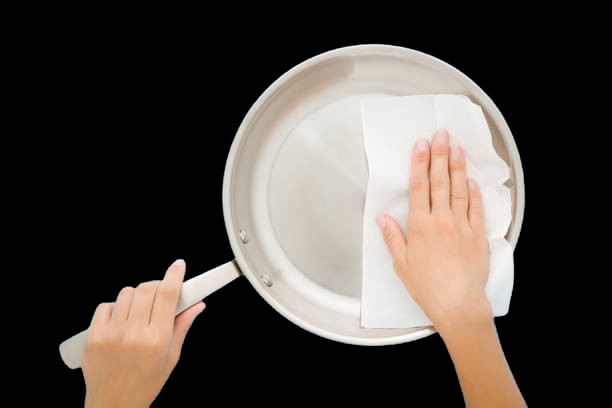
How To Clean Aluminum Pans
Cleaning aluminum pans is essential to maintain their appearance and functionality. Here are three effective ways to clean aluminum pans:
Step 1: Inspection And Assessment
Before diving into any cleaning process for aluminum pans, it’s crucial to begin with a thorough inspection and assessment.
This step sets the foundation for understanding the extent of cleaning required and helps in choosing the most appropriate cleaning method.
Start by examining the entire surface of the aluminum pan, including the interior, exterior, handles, and any crevices or corners.
Look for signs of food residue, grease buildup, burnt stains, or discoloration. Pay attention to areas that are commonly overlooked, such as the edges and rims of the pan.
Once you’ve identified the areas that need attention, assess the severity of the stains or residues. Some pans may only require a light cleaning, while others may have stubborn, baked-on stains that need more intensive treatment.
Consider the type of residue as well, such as burnt food particles, oil splatters, or water spots, as different cleaning methods may be more effective for specific types of stains.
During the inspection and assessment process, also check for any damage to the pan, such as dents, scratches, or warping. While cleaning can improve the appearance of the pan, it’s essential to note any structural issues that may affect its performance or safety during cooking.
By thoroughly inspecting and assessing the aluminum pan before cleaning, you can tailor your cleaning approach to address specific issues effectively. This proactive step ensures that you achieve optimal cleaning results while preserving the quality and longevity of your aluminum cookware.
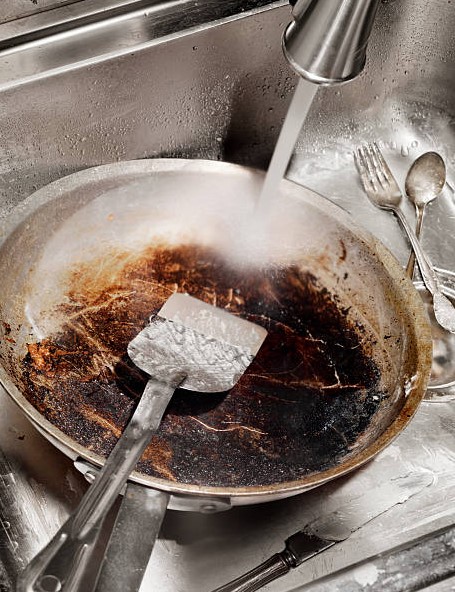
Step 2: Cooling And Washing
After completing the inspection and assessment of your aluminum pan, the next step is to allow the pan to cool down if it was recently used for cooking.
This cooling period is essential to prevent any burns or injuries during the cleaning process. Once the pan has cooled to a safe temperature, you can proceed with washing it.
Start by rinsing the pan under warm water to remove any loose debris or food particles. Use a soft sponge or cloth to gently scrub the surface of the pan, focusing on areas with visible stains or residue. Avoid using abrasive materials or harsh cleaners that can scratch or damage the aluminum.
Next, prepare a solution of mild dish soap and warm water in a sink or basin. Submerge the aluminum pan in the soapy water and use a sponge or brush to scrub the entire surface thoroughly. Pay close attention to corners, edges, and handles where grease and food residue may accumulate.
If there are stubborn stains or burnt-on food, you may need to use a non-abrasive scrubbing pad or brush specifically designed for non-stick cookware.
Be gentle yet firm to avoid scratching the aluminum surface. For tougher stains, you can create a paste using baking soda and water, applying it to the stained areas and letting it sit for a few minutes before scrubbing.
Once you’ve cleaned the pan thoroughly, rinse it with warm water to remove any soap residue. Inspect the pan again to ensure all stains and residues have been removed. If necessary, repeat the washing process until the pan is clean and free from any leftover residue.
After washing, dry the aluminum pan with a soft towel or allow it to air dry completely. Avoid using abrasive materials or harsh cloths that can scratch the surface. Proper drying helps prevent water spots and keeps the pan looking shiny and new.
By following these steps for cooling and washing your aluminum pan, you can maintain its cleanliness and prolong its lifespan for many more cooking adventures.

Step 3: Choosing Your Fighter
Once you’ve completed the initial cooling and washing steps for your aluminum pan, it’s time to select the right cleaning agent to tackle any remaining stains or stubborn residue. Here are several options you can consider:
Vinegar
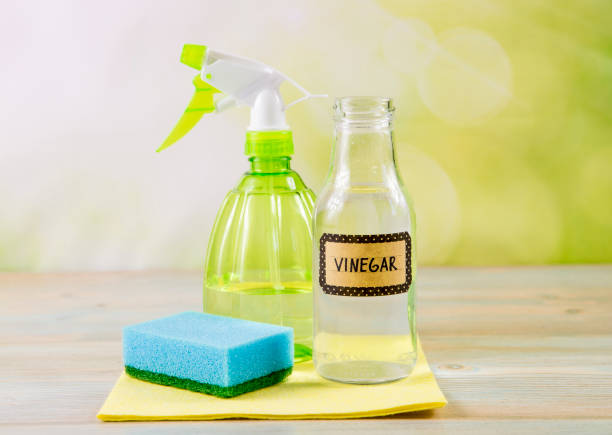
Vinegar is a highly versatile and effective cleaning agent for aluminum pans, thanks to its acidic nature. White vinegar or apple cider vinegar can be used to tackle a variety of stains and residues.
To clean with vinegar, simply pour a generous amount onto the stained areas of the aluminum pan and let it sit for a few minutes to penetrate the residue.
The acidity of the vinegar helps to break down grease, burnt-on food particles, and discoloration.
After allowing the vinegar to work its magic, use a non-abrasive sponge or cloth to scrub the pan gently. Rinse the pan thoroughly with water to remove the vinegar and any loosened residue.
Vinegar not only cleans effectively but also helps neutralize odors, leaving your aluminum pan fresh and ready for your next cooking adventure.
Cream Of Tartar

Cream of tartar is a gentle yet effective cleaning agent for aluminum pans, particularly useful for tackling stains and discoloration. It’s a mild acid that helps break down stubborn residues without causing damage to the aluminum surface.
To use cream of tartar for cleaning, create a paste by mixing it with a small amount of water until you achieve a thick consistency. Apply the paste to the stained areas of the aluminum pan and let it sit for a few minutes to work its magic.
The mild acidity of cream of tartar helps lift stains and restore the pan’s shine. After allowing the paste to sit, scrub the pan gently with a non-abrasive sponge or cloth, focusing on areas with tough residues.
Rinse the pan thoroughly with water to remove the paste and any loosened residue. Cream of tartar is a safe and natural option for cleaning aluminum pans, leaving them looking clean and refreshed.
Baking Soda And Hydrogen Peroxide
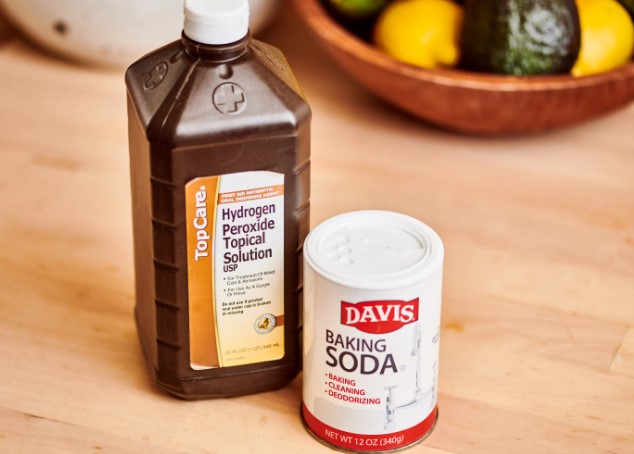
A combination of baking soda and hydrogen peroxide can be a powerful solution for cleaning stubborn stains and baked-on residue from aluminum pans.
Baking soda, known for its abrasive properties, helps to scrub away grime while hydrogen peroxide acts as a gentle bleach and disinfectant. To use this cleaning method, start by sprinkling baking soda generously over the stained areas of the aluminum pan.
Then, pour hydrogen peroxide onto the baking soda to create a foaming reaction. Let the mixture sit for a few minutes to penetrate the stains and loosen the residue.
After the foaming action has subsided, use a non-abrasive sponge or scrubbing brush to scrub the pan thoroughly, focusing on areas with tough residue.
The combination of baking soda and hydrogen peroxide works to break down grease, burnt-on food particles, and tough stains. Rinse the pan with water to remove the cleaning mixture and any loosened residue.
This method is particularly effective for aluminum pans with baked-on residues or stubborn stains, restoring them to a clean and shiny condition. However, it’s essential to rinse the pan thoroughly to remove all traces of the cleaning solution before using it for cooking again.
Combined Solution
A combined solution of vinegar, baking soda, and hydrogen peroxide creates a potent cleaning mixture that is highly effective for tackling tough stains and residues on aluminum pans. Each component plays a unique role in the cleaning process, making this combination versatile and powerful.
To prepare the combined solution, start by sprinkling baking soda over the stained areas of the aluminum pan. Next, pour vinegar onto the baking soda to create a foaming reaction.
Let the mixture sit for a few minutes to allow the baking soda and vinegar to work together in breaking down grease, food particles, and stains.
After the foaming action subsides, add a splash of hydrogen peroxide to the mixture. Hydrogen peroxide acts as a gentle bleach and disinfectant, further enhancing the cleaning power of the solution. Use a non-abrasive sponge or scrubbing brush to scrub the pan thoroughly, focusing on areas with stubborn residues.
Rinse the pan with water to remove the cleaning mixture and any loosened residue. This combined solution effectively removes tough stains and restores the shine of aluminum pans. However, ensure thorough rinsing to eliminate all traces of the cleaning solution before using the pan for cooking again.
Acidic Fruits
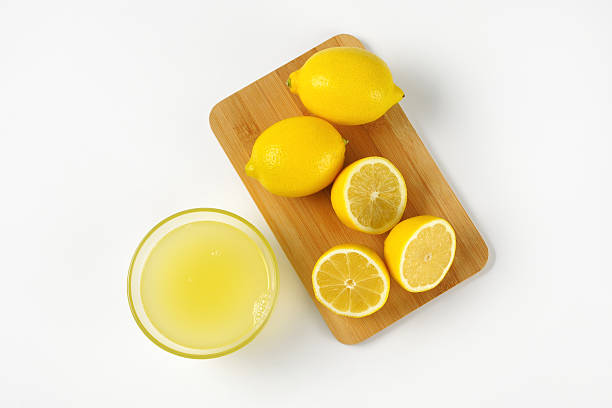
Using acidic fruits like lemons or oranges is a natural and effective way to clean aluminum pans, especially for removing stains and brightening the surface. The natural acidity of these fruits helps break down grease, grime, and stubborn residues without harsh chemicals.
To clean with acidic fruits, start by cutting a lemon or orange in half. Sprinkle a small amount of salt on the cut side of the fruit to enhance its abrasiveness. Use the salted fruit as a scrubber to rub the surface of the aluminum pan, focusing on areas with stains or discoloration.
The acidic properties of the fruit, combined with the abrasive action of the salt, work together to lift dirt and residues. For tougher stains, you can also squeeze the juice of the fruit directly onto the stained areas and let it sit for a few minutes before scrubbing.
After scrubbing, rinse the pan thoroughly with water to remove any fruit residues and loosened dirt. This natural cleaning method leaves your aluminum pan clean, fresh, and free from chemical residues, making it safe for cooking.
Salt

Salt is a simple yet effective natural abrasive that can be used to clean aluminum pans. Its granular texture makes it ideal for scrubbing away stuck-on residues, grease, and stains without scratching the surface of the pan.
To clean with salt, sprinkle a generous amount onto the stained areas of the aluminum pan. Add a small amount of water or lemon juice to create a paste, enhancing salt’s abrasive properties.
Use a sponge or scrubbing brush to scrub the pan vigorously, focusing on areas with tough residues. The abrasive action of salt helps loosen and lift dirt and stains, restoring the pan’s shine. Rinse the pan thoroughly with water to remove the salt and any loosened residues.
Salt is a natural and budget-friendly cleaning option for aluminum pans, leaving them clean, fresh, and ready for your next cooking adventure.
Dryer Sheet
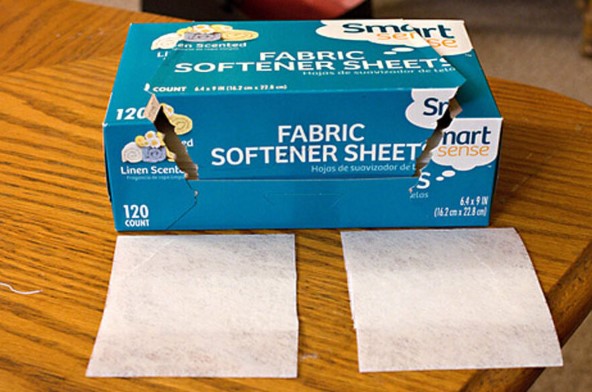
Using a dryer sheet is a surprisingly effective method for removing stuck-on residues and stains from aluminum pans. While dryer sheets are typically used in laundry, their fabric-softening properties and texture make them useful for cleaning purposes as well.
To clean with a dryer sheet, fill the aluminum pan with warm water and add a dryer sheet to the water. Allow the pan to soak for several hours or overnight, depending on the severity of the stains. The chemicals in the dryer sheet help to loosen and break down residues, making them easier to remove.
After soaking, use a sponge or scrubbing brush to scrub the pan, focusing on areas with stubborn residues. The softened residues should come off more easily after soaking. Rinse the pan thoroughly with water to remove any remaining residue and dryer sheet particles.
While using a dryer sheet may seem unconventional, it can be a convenient and effective way to clean aluminum pans, especially for removing tough stains and residues.
Bar Keepers Friend
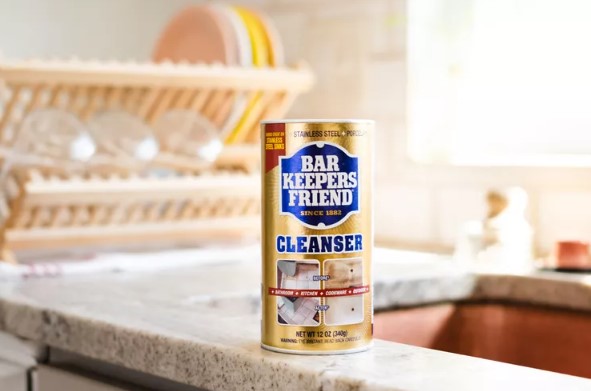
Bar Keepers Friend is a specialized cleaner and polish that is specifically designed for cleaning stainless steel, porcelain, and aluminum surfaces. It is particularly effective for removing tough stains, grease buildup, and tarnish from aluminum pans without causing damage to the metal.
To clean with Bar Keepers Friend, wet the surface of the aluminum pan and sprinkle the cleaner directly onto the stained or soiled areas. Use a non-abrasive sponge or cloth to scrub the pan gently, focusing on areas with stubborn residues.
The mild abrasiveness of Bar Keepers Friend helps lift dirt and stains, while its chemical formula breaks down grease and grime.
After scrubbing, rinse the pan thoroughly with water to remove the cleaner and any loosened residues. Bar Keepers Friend leaves aluminum pans looking clean, shiny, and restored, making it an excellent choice for maintaining the appearance and longevity of your cookware.
Prevention
Prevention is key to keeping your aluminum pans in good condition and extending their lifespan. Here are three preventive measures you can take:
Skip The Dishwasher
Skipping the dishwasher and opting for hand washing is a crucial step in maintaining the quality and appearance of your aluminum pans.
Dishwashers, especially those with high temperatures and harsh detergents, can be harsh on aluminum surfaces, leading to discoloration, dullness, and potential damage over time.
Hand washing allows you to use gentler cleaning agents and control the water temperature, reducing the risk of wear and tear on your pans.
By taking the time to hand wash your aluminum pans with mild dish soap and warm water, you can preserve their shine, prevent corrosion, and extend their lifespan for years of reliable use in your kitchen.
Store Properly
Proper storage of aluminum pans is essential to prevent damage and maintain their quality. When storing your pans, avoid stacking heavy items on top of them, as this can lead to dents, scratches, or warping.
Instead, store pans in a way that minimizes contact with other objects, using protective padding or cloth liners between stacked pans to prevent surface damage.
Moreover, choose a dry and well-ventilated storage area to prevent moisture buildup, which can contribute to corrosion over time.
By storing your aluminum pans properly, you can ensure they remain in good condition, ready for use whenever you need them.
Skip The Acidic Dishes
Skipping the use of acidic dishes in aluminum pans is a smart preventive measure to maintain their integrity and appearance.
Acidic foods, such as tomatoes, citrus fruits, and vinegar-based sauces, can react with aluminum, causing discoloration and potentially affecting the taste of your food.
To avoid these reactions, opt for non-reactive cookware like stainless steel or ceramic for acidic dishes.
This simple step not only preserves the quality of your aluminum pans but also ensures that your meals retain their intended flavors without any metallic aftertaste.

Frequently Asked Questions (FAQs) – How To Clean Aluminum Pans
Q: What’s the best way to clean my aluminum pans to keep them looking shiny and new?
A: To maintain that sparkle, start by soaking your pan in warm, soapy water to loosen any stubborn residue. Then, gently scrub with a non-abrasive sponge or cloth to avoid scratching the surface.
Q: Can I use baking soda to clean my aluminum pans without damaging them?
A: Yes, baking soda is a gentle yet effective cleaner for aluminum pans. Make a paste with water and baking soda, apply it to the pan, and let it sit for a few minutes before rinsing thoroughly.
Q: How do I remove tough stains from my aluminum pans without harsh chemicals?
A: For stubborn stains, try a mixture of equal parts vinegar and water. Let it sit in the pan for a while, then scrub with a soft brush. Rinse well for a gleaming finish.
Q: Is it safe to use lemon and salt to clean my aluminum pans?
A: Absolutely! The acidity of lemon combined with salt creates a natural cleaning agent that works wonders on aluminum pans. Plus, it leaves behind a refreshing scent.
Q: What’s a simple trick to prevent discoloration on my aluminum pans?
A: After cleaning, dry your aluminum pans thoroughly to prevent water spots and potential discoloration. A soft cloth works well for drying without leaving lint behind.
Q: Can I put my aluminum pans in the dishwasher for easy cleaning?
A: While some aluminum pans are dishwasher-safe, handwashing is often recommended to prolong their lifespan and keep them looking pristine.
Q: How often should I deep clean my aluminum pans for optimal maintenance?
A: It’s a good idea to deep clean your aluminum pans every few weeks, especially if you use them frequently. Regular cleaning helps prevent buildup and maintains their shine.
Q: What’s a safe way to clean the exterior of my aluminum pans to remove grease and stains?
A: For the exterior, use a mild dish soap and warm water with a soft cloth or sponge. Avoid harsh abrasives that can scratch the surface and dull the finish.
Q: Can I use natural ingredients like vinegar and baking soda together to clean my aluminum pans?
A: Yes, combining vinegar and baking soda creates a powerful yet gentle cleaning solution for aluminum pans. The fizzing action helps lift dirt and stains effectively.
Q: What’s a quick and easy way to clean burnt-on residue from my aluminum pans?
A: Try boiling water in the pan with a few tablespoons of baking soda. Let it simmer for a few minutes, then use a spatula or wooden spoon to gently scrape off the residue. Follow up with regular dishwashing for a spotless finish.
Conclusion
Cleaning aluminum pans is a straightforward process that ensures their longevity and maintains their cooking performance.
By following the recommended methods of gentle scrubbing with mild dish soap, avoiding harsh abrasives, and using non-abrasive cleaning tools, you can keep your aluminum pans looking new and free from stubborn stains.
Moreover, proper drying and storage after cleaning help prevent water spots and corrosion. With these cleaning tips in mind, you can enjoy using your aluminum pans for years to come, creating delicious meals without worrying about their upkeep.
Other Articles You May Also Like:
- How To Clean Calphalon Pans (7 Essential Steps)
- How To Clean Stainless Steel Pans (13 Cool Ways)
- How To Clean Ceramic Pan (10 Easy Ways)
- How To Clean Stove Drip Pans (8 Easy Ways)
- How To Clean Muffin Pan (4 Easy Steps)
- How To Clean Burnt Pan (23 Cool Ways)
- How To Clean Stainless Steel Pans (13 Cool Ways)
- How To Clean Pots And Pans To Look Like New (8 Best Ways)